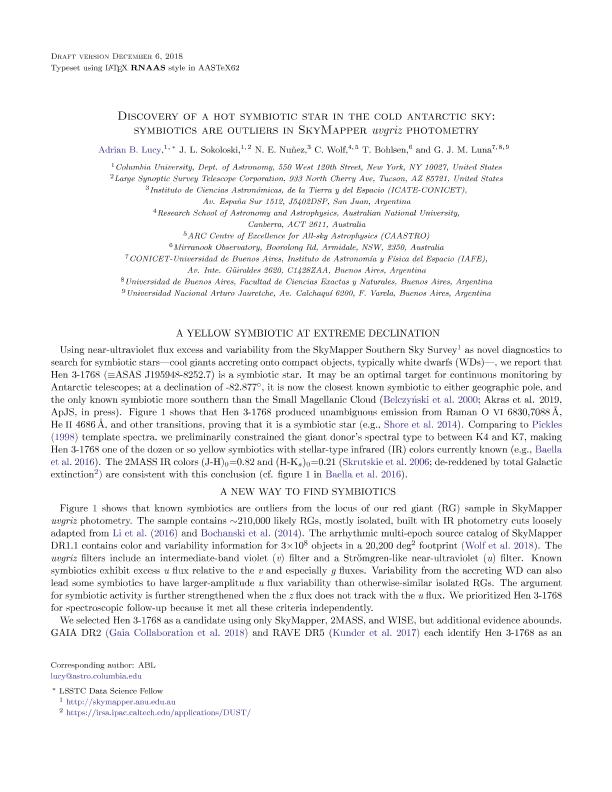Mostrar el registro sencillo del ítem
dc.contributor.author
Lucy, Adrian B.
dc.contributor.author
Sokoloski, J. L.
dc.contributor.author
Nuñez, Natalia Edith

dc.contributor.author
Wolf, C.
dc.contributor.author
Bohlsen, T.
dc.contributor.author
Luna, Gerardo Juan Manuel

dc.date.available
2019-07-31T15:24:54Z
dc.date.issued
2018-12
dc.identifier.citation
Lucy, Adrian B.; Sokoloski, J. L.; Nuñez, Natalia Edith; Wolf, C.; Bohlsen, T.; et al.; Discovery of a Hot Symbiotic Star in the Cold Antarctic Sky: Symbiotics Are Outliers in SkyMapper uvgriz Photometry; IOP; Research Notes of the AAS; 2; 4; 12-2018; 1-4
dc.identifier.issn
2515-5172
dc.identifier.uri
http://hdl.handle.net/11336/80669
dc.description.abstract
Using near-ultraviolet flux excess and variability from the SkyMapper Southern Sky Survey11 as novel diagnostics to search for symbiotic stars?cool giants accreting onto compact objects, typically white dwarfs (WDs), we report that Hen 3-1768 (≡ASAS J195948?8252.7) is a symbiotic star. It may be an optimal target for continuous monitoring by Antarctic telescopes; at a decl. of −82877, it is now the closest known symbiotic to either geographic pole, and the only known symbiotic more southern than the Small Magellanic Cloud (Belczyński et al. 2000; Akras et al. 2019, ApJS, in press). Figure 1 shows that Hen 3-1768 produced unambiguous emission from Raman O vi 6830,7088 Å, He ii 4686 Å, and other transitions, proving that it is a symbiotic star (e.g., Shore et al. 2014). Comparing to Pickles (1998) template spectra, we preliminarily constrained the giant donor´s spectral type to between K4 and K7, making Hen 3-1768 one of the dozen or so yellow symbiotics with stellar-type infrared (IR) colors currently known (e.g., Baella et al. 2016). The 2MASS IR colors (J − H)0 = 0.82 and (H − Ks)0 = 0.21 (Skrutskie et al. 2006; de-reddened by total Galactic extinction12 ) are consistent with this conclusion (see Figure 1 in Baella et al. 2016).
dc.format
application/pdf
dc.language.iso
eng
dc.publisher
IOP
dc.rights
info:eu-repo/semantics/openAccess
dc.rights.uri
https://creativecommons.org/licenses/by-nc-sa/2.5/ar/
dc.subject
Symbiotic
dc.subject
Skymapper
dc.subject.classification
Astronomía

dc.subject.classification
Ciencias Físicas

dc.subject.classification
CIENCIAS NATURALES Y EXACTAS

dc.title
Discovery of a Hot Symbiotic Star in the Cold Antarctic Sky: Symbiotics Are Outliers in SkyMapper uvgriz Photometry
dc.type
info:eu-repo/semantics/article
dc.type
info:ar-repo/semantics/artículo
dc.type
info:eu-repo/semantics/publishedVersion
dc.date.updated
2019-07-30T13:56:51Z
dc.journal.volume
2
dc.journal.number
4
dc.journal.pagination
1-4
dc.journal.pais
Estados Unidos

dc.journal.ciudad
Nueva York
dc.description.fil
Fil: Lucy, Adrian B.. Columbia University; Estados Unidos
dc.description.fil
Fil: Sokoloski, J. L.. Columbia University; Estados Unidos
dc.description.fil
Fil: Nuñez, Natalia Edith. Consejo Nacional de Investigaciones Científicas y Técnicas. Centro Científico Tecnológico Conicet - San Juan. Instituto de Ciencias Astronómicas, de la Tierra y del Espacio. Universidad Nacional de San Juan. Instituto de Ciencias Astronómicas, de la Tierra y del Espacio; Argentina
dc.description.fil
Fil: Wolf, C.. Research School Of Astronomy And Astrophysics, Anu; Australia
dc.description.fil
Fil: Bohlsen, T.. Mirranook Observatory,; Australia
dc.description.fil
Fil: Luna, Gerardo Juan Manuel. Consejo Nacional de Investigaciónes Científicas y Técnicas. Oficina de Coordinación Administrativa Ciudad Universitaria. Instituto de Astronomía y Física del Espacio. - Universidad de Buenos Aires. Facultad de Ciencias Exactas y Naturales. Instituto de Astronomía y Física del Espacio; Argentina
dc.journal.title
Research Notes of the AAS
dc.relation.alternativeid
info:eu-repo/semantics/altIdentifier/doi/http://dx.doi.org/10.3847/2515-5172/aaf71c
Archivos asociados
